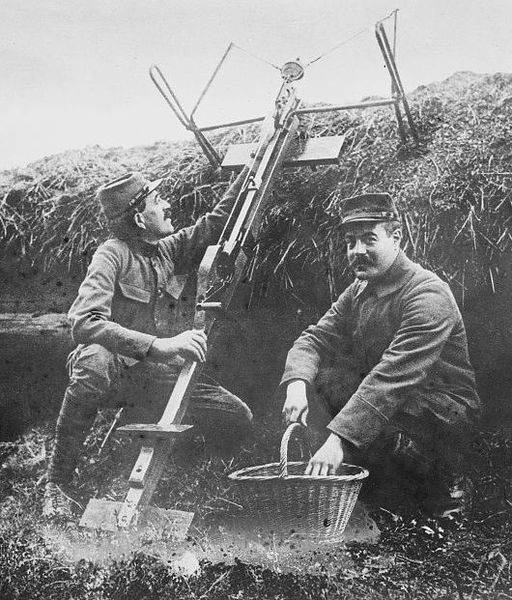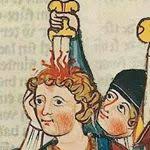|
No, they aren't that thin. https://www.kunst-waffenkammer.de/en/waffen/blankwaffen-militaer/kriegssichel-steyrisch/ http://www.faganarms.com/german-or-swiss-war-sickle-kriegssichel-c-1550-1600-9582.aspx http://en.wikipedia.org/wiki/War_scythe http://de.wikipedia.org/wiki/Bauernwehr Those have been reworked as a polearm, but the one that I thought about would be like a Falx.
|
|
|
|

|
| # ? May 22, 2024 13:23 |
|
Iseeyouseemeseeyou posted:I thought sodomy would be a big no-no in medieval reenactments? I don't really know that much about the smaller orders to be honest, but I can post some of what I do know. The smaller military orders I know of are kind of reminiscent of smaller monastic orders in that they pretty much organized themselves along the lines of one of the bigger orders adapting their rule and such for themselves, in many instances becoming a vassal outshoot of a larger order, often with a regional or linguistic niche. The Teutonic Order for an example got started because the Hospitalers were ordered by the Pope to take over administration and protection of a hospital for German pilgrims (who could not speak French or Latin) in Jerusalem, but they were also given instructions that the knights assigned to this hospital, including the superior officer of that hospital be Germans so they could interact directly with the pilgirms, over time this grew into a separate order of its own. The Knights of Montjoie are a similar example being a sub-order of the Templars, following their rule, composed almost entirely of Spanish recruits, though that order never really grew big like the Teutonic Order. It really seems as if most orders were in some respect "vassals" of either the Hospitalers or the Templars, most people who joined an order would join one of these and might then join another one of the subsidiary orders through them. An interesting order is the Order of St. Lazarus, which grew out of a hospital in Jerusalem caring for lepers, all knights who joined were lepers and I think both the Templars and Hospitalers sent members afflicted leprosy to join the order. Recruits meanwhile came from a variety of sources, though knights had to have been actual knights trained for war, it wasn't all that uncommon for courts to sentence a warrior to join a military order to cleanse their sins or for some knight who lost his family or could not provide for himself to join an order. In addition to knights you would have the sergeants (from "servientes" meaning "servants") who provided a host of support duties both of a military and civilian nature, and otherwise lived monastic lives like the knights themselves, in addition to that you had many other non-military members, usually back in Europe such as adminstrators (often older knigths and nobles) and nuns. This mostly goes for the Templars and Hospitalers, but the smaller orders were much the same, but they appear to often have had a negligible amount of knights compared to the big orders, and often were dependent on them for receiving military members in the first place.
|
|
|
|
JaucheCharly posted:http://www.faganarms.com/german-or-swiss-war-sickle-kriegssichel-c-1550-1600-9582.aspx
|
|
|
|
Are you seriously doubting that agricultural tools have been reworked to serve as weapons? The german peasant wars would give you some idea what the people had to use. http://blankwaffen-lexikon.de/lexikon/Kriegssense Power Khan fucked around with this message at 20:09 on Oct 20, 2014 |
|
|
|
Railtus posted:As a sidenote, prostitution was officially banned in the tross of the landsknecht, but they named an officer responsible for keeping order in the tross as (from memory) “hurenwebel” or “whore-sergeant.” No, really.
|
|
|
|
JaucheCharly posted:Are you seriously doubting that agricultural tools have been reworked to serve as weapons? The german peasant wars would give you some idea what the people had to use. So it was a weaponized design based on a familiar form. Edit: Ok, later he says that "During the peasant war in Austria, smiths that changed field sickles into war sickles where punished by death". So probably both. It started out as converted field sickle, and after it proved to be useful new sickles were specially constructed for the use as weapon. Edit: That article you linked uses both names as synonyms and describes it as having one sickle-like blade. Although it describes the thing on your image below too and calls it "a kind of Sturmsense" that was used in 1863 when vienna was defended against the turks. Nektu fucked around with this message at 20:43 on Oct 20, 2014 |
|
|
|
A Sturmsense is this thing here, not to be confused with Kriegssense.
|
|
|
|
JaucheCharly posted:A Sturmsense is this thing here, not to be confused with Kriegssense. yo post the world war 1 crossbow
|
|
|
|
There you go. It's large. Like 2m long? I can't recall.
|
|
|
|
HEY GAL posted:yo post the world war 1 crossbow This one? 
|
|
|
|
JaucheCharly posted:There you go. World war 1 is really cool and the most horrible thing ever at the same time, for the same reason
|
|
|
|
JaucheCharly posted:Are you seriously doubting that agricultural tools have been reworked to serve as weapons? The german peasant wars would give you some idea what the people had to use.
|
|
|
|
Not very popular with nobility heh.
|
|
|
|
Randarkman posted:In the 12th century and later full chainmail armor was usually multiple layers, and covered both arms and legs, even including mailed mittens and leggins. This would be what most knightly heavy cavalry wore, though I can admit that it probably in many cases is not as heavy as full suits plate armor, when you have these heavy, all covering chainmail hauberks, the difference will be much less and the plate armor will still distribute the weight alot better and offer better protection. So just to reiterate, what you said is 'Plate armor really was not that much more heavy than a chainmail hauberk'. What you meant is 'Plate armour is not that much more heavy than full mail armour of the 13th century and later'. So part of this was a language issue. But here, too, we see inaccuracy. Multiple layers of mail were NOT usual, except in tournament. Though we do sometimes see them in combat such men are clearly the exception. In the Rule of the Temple, for example, knights are allowed only a single hauberk. In one of the instances when Don Pero Nińo's armour is described in El Victorial, he is wearing a (singular) coat of mail. quote:I think knights in Outremer more often used elbow length chainmail hauberks, mail aventails instead of mail coifs, and favored conical helmets, skull caps and kettle hats and other styles of open helmets rather than closed helmets like the great helm. This is not backed up by our historical sources. The Rule of the Temple explicitly enumerates that brother knights would have coifs, and images we have of knights in similar climates show the use of great helms. I also find it strange you do not think plate harness and the armet, bascinet, and great bascinet so confining as to be discarded but think the great helm to be so. quote:You should also consider that usually armor would not be worn while on the march or when combat was not imminent, that's part of the reason why knigths were accompanied by squires and other servants, as they could assist the knight in putting on his armor. How do you mean, 'imminent'? Gutierre Diaz de Gamez mentions that knights at war slept 'with their armour still on their backs', and armies on the march in enemy territory would indeed have their troops armoured, in case of skirmishing. This is especially true for high medieval warfare where ravaging and siege (and their concomitant skirmishing) were the course of the day. quote:Also people seem to have the misconception that the Middle East is all scorching desert, which is simply not true, especially of the areas of greatest action during the Crusades which would be modern day Lebanon, Palestine and Israel, much of this area has a mediterranean climate not really that different from Italy, Spain, Turkey or Greece, yet no one really bats an eyelid at Italians going into battle in full armor or Byzantine cataphracts. Can you point out these people in the thread? Because I have yet to see anyone on here ever argue that Islamic combatants did not wear metal armor. quote:A big difference was that European soldiers made much greater use of padded cloth armors than the Muslims did, particularly when it came to using these as padding to give increased protection to a soldier already wearing another armor over it Based on what evidence? Jean de Joinville, at the Battle of Mansurah, uses "a gambeson, stuffed with wadding, that had belonged to a Saracen" as a shield, against arrows. He also mentions that thick turbans were commonly worn to protect against sword blows. Hell, the word Aketon comes from the Arabic for "cotton". JaucheCharly posted:Maybe Rodrigo can explain better why they didn't produce lots of plate, but I think it has to do with the fact that some dudes in Italy or Germany invented a procedure where they could produce larger quantities of quality steel with less effort and resources. Also, producing steel eats shitloads of wood, so basically any place around the southern mediterranean isn't an ideal place for large scale steel production. It was Catalans, actually, who invented the (water powered, of course, because this is the age of water power) Catalan forge, which produced what were essentially much larger bloom yields than the traditional stack furnace. Other than that, you've more or less got it on the nose, but it should be mentioned that you have these geographic advantages in loads of other places (Near Velikiy Novgorod, for example) and the big reason high-quality steel production isn't more widespread is that ultimately this knowledge was highly guarded. To get an idea of just how highly guarded, field armour actually decreased in quality of material during the 16th century because the best artisans kept being commissioned for parade armour. Randarkman posted:On a more general note a common theme (especially in England and France) as the Middle Ages progressed was the feudal vassals went from rendering dues to their liges in the form of military service and more and more came to render it in the form of payments, in cash, grain or material, this was actually encouraged by many kings as they would use these payments to hire professional soldiers (usaully mercenaries) and build up a full time, standing royal army, an essential prerequisite when moving towards a centralized state and away from feudalism. By and large mercenaries (stipendarii) were preferred in war except in cases of national emergency (such as the threat of German invasion of France in 1124). A form of standing royal army has existed since the earliest days of the Middle Ages as the comitatus, and later the familia regis. Because of the comparatively undeveloped state of taxation and its bureaucracy until the 14th and 15th centuries, these bodies of men would be more or less numerous depending on need, but they were always available. It is members of William Rufus's familia, for example, that guarded the castle of Le Mans in 1099 during the war with Count Helias, and it was mercenaries that Rufus hired to come to their relief. deadking posted:Since there's been a lot of sword-chat recently, I thought I'd ask this here. I was reading the Miracles of Sainte Foy (11th century) today and I came across a reference to a warrior (miles) defending himself with a "peasant's version of a sword." Does anyone have any idea what this is referring to? Unfortunately I only have the translation in front of me, not the Latin. The original Latin would be an immense help. However, it was most likely some kind of long knife, as everyone has speculated, possibly along the lines of a langseax, since we don't see grossemessers (and afaik the laws requiring them) until the 14th or 15th century. Another possibility is that the author means a foot-soldier's sword, which would notionally be shorter than a cavalryman's. JaucheCharly posted:No, they aren't that thin. Here we come across a language problem, since in English a sickle is explicitly single-handed and used for cutting grasses, whereas the kriegssichels come from tools that in English would typically be called bills, and were for hewing heavier stuff. Though I will mention Paulus Hector Mair shows fighting with sickles http://paulushectormair.blogspot.com/2009/11/mairs-sickle-1-oberhauen-from-both.html
|
|
|
|
Rodrigo Diaz posted:This is not backed up by our historical sources. The Rule of the Temple explicitly enumerates that brother knights would have coifs, and images we have of knights in similar climates show the use of great helms. I also find it strange you do not think plate harness and the armet, bascinet, and great bascinet so confining as to be discarded but think the great helm to be so. I might mostly be stuck in the 12th century when it comes to the Crusades, and I kind of stopped mid-way in listing types of helmets as those were the only ones that came to midn and the armet and bascinet are somewhat later as I recall (and I think they also usually had detchable visors, though many great helms had this as well), and 12th century would really be before plate armor at all really, though you get the coat of plates in the 13th century. quote:How do you mean, 'imminent'? Gutierre Diaz de Gamez mentions that knights at war slept 'with their armour still on their backs', and armies on the march in enemy territory would indeed have their troops armoured, in case of skirmishing. This is especially true for high medieval warfare where ravaging and siege (and their concomitant skirmishing) were the course of the day. It's possible that I got this confused because I was just reading through some books again and came across a reference to Islamic armies in Saladin's time marching with most of their armor stored in a portable arsenal, so I might simply have misremembered it as referring to armies in general. quote:Can you point out these people in the thread? Because I have yet to see anyone on here ever argue that Islamic combatants did not wear metal armor. Never referred at all to people in the thread, though it certainly is the case that people in general seem to think that Muslims during the Crusades fought unarmored or lightly armored against knights in plate armor. quote:Based on what evidence? Jean de Joinville, at the Battle of Mansurah, uses "a gambeson, stuffed with wadding, that had belonged to a Saracen" as a shield, against arrows. He also mentions that thick turbans were commonly worn to protect against sword blows. Hell, the word Aketon comes from the Arabic for "cotton". I'm going to have to look this up, since its based mostly on what I seem to recall from stuff I have been reading for quite a time. Even so less use of padded cloth armors does not mean their absence. quote:By and large mercenaries (stipendarii) were preferred in war except in cases of national emergency (such as the threat of German invasion of France in 1124). A form of standing royal army has existed since the earliest days of the Middle Ages as the comitatus, and later the familia regis. Because of the comparatively undeveloped state of taxation and its bureaucracy until the 14th and 15th centuries, these bodies of men would be more or less numerous depending on need, but they were always available. It is members of William Rufus's familia, for example, that guarded the castle of Le Mans in 1099 during the war with Count Helias, and it was mercenaries that Rufus hired to come to their relief. Yes? I don't see how this contradicts what I said at all which was that as the Middle Ages progressed the scutage became more and more common to be paid by vassals in lieu of being required to maintain and provide troops for their liege, doesn't mean there weren't mercenaries before then.
|
|
|
|
How many of you have worn plate in the summer? I have, in Germany and Bohemia, which are cold countries. It blows rear end. And I'm just wearing breast, back, and helmet. Tassets only when I get a lecture about wearing tassets. I wear as little as it is possible to get away with when there's an authority figure cruising around me, that is not the half of what these dudes wear. I don't even wear leather gloves. Everyone else wears leather gloves.Randarkman posted:I think knights in Outremer more often used elbow length chainmail hauberks, mail aventails instead of mail coifs, and favored conical helmets, skull caps and kettle hats and other styles of open helmets rather than closed helmets like the great helm. Rodrigo Diaz posted:This is not backed up by our historical sources. The Rule of the Temple explicitly enumerates that brother knights would have coifs, and images we have of knights in similar climates show the use of great helms. I also find it strange you do not think plate harness and the armet, bascinet, and great bascinet so confining as to be discarded but think the great helm to be so. Each one of these is as stifling as the next. Armet:   Bascinet:   Great Bascinet:   and the Great Helm  
HEY GUNS fucked around with this message at 23:45 on Oct 20, 2014 |
|
|
|
HEY GAL posted:How many of you have worn plate in the summer? I have, in Germany and Bohemia, which are cold countries. It blows rear end. And I'm just wearing breast, back, and helmet. Tassets only when I get a lecture about wearing tassets. I wear as little as it is possible to get away with when there's an authority figure cruising around me, that is not the half of what these dudes wear. I don't even wear leather gloves. Everyone else wears leather gloves. I've worn it in the Texas summer, and at least on horseback with the visor up the breeze made it bearable as long as you were moving. I agree with you though, as sitting still baking in the sun or (obviously) marching in it was hellish.
|
|
|
|
Rodrigo Diaz posted:Here we come across a language problem,
|
|
|
|
how much trauma does it take to bust some heavy armor like that? Are there any busted helmet artifacts remaining from those times?
|
|
|
|
Here's a bit of a fun video. https://www.youtube.com/watch?v=L0LpsnO0E4U Roland of Dimicator talks about George Silver's concept of fighting in True Time, where you maximize the potential speed and tempo of an attack by following the concept of hands moving faster than torso moving faster than feet, and applies this to sword and buckler fencing from I.33.
|
|
|
|
deadking posted:Since there's been a lot of sword-chat recently, I thought I'd ask this here. I was reading the Miracles of Sainte Foy (11th century) today and I came across a reference to a warrior (miles) defending himself with a "peasant's version of a sword." Does anyone have any idea what this is referring to? Unfortunately I only have the translation in front of me, not the Latin.
|
|
|
|
Ofaloaf posted:Where does it mention that? There's a Latin version of the Miracles of Saint Foy on Google Books (with a French preface), so if you can match up the lines there that might do the job. It's section I.10, "How celestial vengeance struck a man who attacked Sainte Foy's pilgrims." The Latin phrase Sheingorn translates as "He grabbed up the peasant's version of a sword" is arrepta rusticana framea. I'm not familiar with the word framea but a quick look at a dictionary suggests that in classical Latin it's a type of spear. Du Cange, however, defines it as a type of sword which is sharp on both sides. Both dictionaries suggest the word is probably Germanic in origin. deadking fucked around with this message at 20:01 on Oct 22, 2014 |
|
|
|
http://en.wikipedia.org/wiki/Migration_Period_spear
|
|
|
|
Quick, possibly weird question-one of my favorite weapons just in terms of aesthetics is the kanabo, but I'm having trouble finding anything about its actual place/usage in history. I have to imagine that it was used much like any other blunt weapon, but most weapons I'm familiar with made to deal blunt trauma seem to either be one-handed, or are polearms that are also capable of stabbing/cutting, while kanabo(unless I am missing something) are just two-handed big gently caress-off clubs... which strikes me as rather unwieldy and I'm not sure what context that would be useful in. I'm having a lot of trouble finding anything not-bullshit related to them, so I guess I'm essentially just wondering if these were actually used to any real extent, and if so, for what purpose.
|
|
|
|
Here's a video showing the hilt choke technique from Gladiatoria.
|
|
|
|
Did the Japanese just not use shields? What's up with that?
|
|
|
|
It's been mentioned loads of times throughout the thread but yes they did use shields, just not ones you'd carry in your hands.
|
|
|
|
Personal shields were used up until the fifth century or so, and afterwards as movable cover similar to European pavises.  Early samurai fought as cavalry archers, so their armor evolved and grew the distinctive plates called o-sode, which are basically shoulder-shields. Meanwhile footmen apparently opted for polearms like the naginata to deal with the rich assholes on horses, so they didn't have an arm free. Later, the invading Mongols and Chinese forced the Japanese to rely more on infantry, so they took a page from the invaders and figured out pike block tactics, and a couple of centuries later reinforced the blocks with arquebusiers. Or something like that.
|
|
|
|
Siivola posted:Later, the invading Mongols and Chinese forced the Japanese to rely more on infantry, so they took a page from the invaders and figured out pike block tactics... Speaking of, Rabadh, weren't you going to write something...?
|
|
|
|
HEY GAL posted:Speaking of, Rabadh, weren't you going to write something...? Soon, have a puffer for the wait. https://www.youtube.com/watch?v=nJ7Sg_izbUI
|
|
|
|
Rabhadh posted:Soon, have a puffer for the wait. Edit: Not sure if I mentioned this before, but I met a guy at a reenactment once who had a pistol that was both wheellock and matchlock. You could flip a little lever to switch from one mechanism to the other. It was interesting, but God only knows why; that entire period had a real weakness for complex overengineered bullshit. HEY GUNS fucked around with this message at 15:56 on Oct 25, 2014 |
|
|
|
Siivola posted:Personal shields were used up until the fifth century or so, and afterwards as movable cover similar to European pavises. Pressure from the Mongols was more of a sharp shock sort of thing. The big changes there were the fortification efforts on the coast and the resulting weakening of the shogunate because a. they poured a bunch of resources into forts that were in really peripheral areas and b. the traditional way to reward warriors was to parcel out the lands of the defeated. Fine in most fights but when winning means "not being slaughtered by angry Mongols" there isn't much by way of spoils. Blah blah centuries of in fighting. And THAT'S when they really got on the pike train. (Also Maurician fire drill before Maurice, because Oda don't gently caress around.)
|
|
|
|
IronicDongz posted:Quick, possibly weird question-one of my favorite weapons just in terms of aesthetics is the kanabo, but I'm having trouble finding anything about its actual place/usage in history. I have to imagine that it was used much like any other blunt weapon, but most weapons I'm familiar with made to deal blunt trauma seem to either be one-handed, or are polearms that are also capable of stabbing/cutting, while kanabo(unless I am missing something) are just two-handed big gently caress-off clubs... which strikes me as rather unwieldy and I'm not sure what context that would be useful in. I'm having a lot of trouble finding anything not-bullshit related to them, so I guess I'm essentially just wondering if these were actually used to any real extent, and if so, for what purpose. To clarify for anybody else reading, the Japanese "kanabo" is one of the names for a category of staff or club-like weapons either made entirely of metal or from wood reinforced with metal. There's a lot of variation in size, design, and construction but the most common depiction is something like a five-foot baseball bat with the business end covered with a spiked metal sleeve, or just metal spikes embedded directly into the wood. Basically a heavy two-handed club. The kanabo is referred to in a lot of myth/folklore as the characteristic weapon of the oni and even features in a commonplace expression--"oni with an iron club," meaning not just strong but invincibly strong--which probably reflects that it was in use at some point. There are also the all-important surviving historical examples. It doesn't mean that the kanabo was necessarily a common weapon, of course, just that it was around. And in fact your difficulty finding more information about the martial as opposed to mythical uses of the weapon probably indicates that it wasn't as common or as highly regarded as weapons like the sword, bow, spear, etc. I think the classic claim about the kanabo is that it was a powerful weapon to be used by infantry to break the legs of warhorses, and I honestly don't know what to make of that. There are also a couple types of sword (zanbato, a two-handed sword with an extremely long blade, and nagamaki, a two-handed sword with an extremely long handle, almost a polearm) that were supposedly used for the same purpose of attacking cavalry at the legs. Speaking speculatively, Japan is a fairly iron-poor country what ore they do have is pretty low quality. The kanabo is composed mostly of wood with only comparatively small amounts of metal, which are also relatively easy to make (i.e. iron spikes). Even the versions that are entirely metal would be simple to produce compared to a usable sword, since they're pretty much just an iron bar. The kanabo might be a way of making do with what you have, being a reasonably effective two-handed weapon for a foot soldier that could be turned out in short order by any blacksmith. Another possible reason we might not hear as much about the martial techniques of the kanabo is that it might have been a battlefield weapon rather than an individual one. As big and heavy as it was, it wouldn't be as practical as a sword for a carry weapon for dueling and self-defense, but if you were a foot soldier charging into a confused brawl it'd probably serve pretty well. quote:I have to imagine that it was used much like any other blunt weapon, but most weapons I'm familiar with made to deal blunt trauma seem to either be one-handed, or are polearms that are also capable of stabbing/cutting, I just wanted to pull this bit out to address it, because it's not exactly true. Staves like shepherd's crooks, walking sticks, and so forth were very commonly used, particularly for self-defense by people who couldn't afford swords. e.g. the commonplace English phrase "to stave off" probably derives from fighting off an attack with your walking stick. In Paradoxes of Defense the English martial arts writer George Silver argued that the short staff (better known these days as a quarterstaff) was the ideal personal weapon, because of its length and speed. At 8'-9' it was long enough to severely outrange opponents with most one- and two-handed weapons, but short enough to be handy in close distances, and more nimble than polearms of similar length because it lacked the mass of metal at one end. It's probably de rigeur at this point to note that the usual modern image of quarterstaff technique has the combatant gripping it near the middle of the staff (as in the boy scouts manual of quarterstaff), but historically it was gripped close to one end to maximize the advantage of its length. There are some cool HEMA videos of it being used correctly, and it looks like it would be a nightmare getting your sword anywhere near to a guy who knew how to use a quarterstaff. There are also a couple surviving stickfighting arts, canne de combat in France and jogo do pau in Portugal. One of the events in canne de combat is baton, which uses a two-handed stick of about 55", which is also about the standard length of a stick for jogo do pau. It's also around the right length for a good walking stick, or a good two-handed sword. A lot of the techniques in both arts are visually similar to those used by the two handed longsword, although different in some respects because it can be gripped anywhere along its length, and has no crossguard for striking with. There are also neat videos of those being used, but they're performance or sporting forms now rather than combatives. I believe shillelaghs were also often two-handed, although they were more clubs than staves. At any rate, at first blush staves wouldn't seem to be as lethal as bladed weapons but they actually applied quite a lot of force thrusting or striking--enough to break bones, knock a guy unconscious, or even kill outright, particularly against an unarmored opponent as you might meet in a self-defense scenario.
|
|
|
|
I do jodo, its awesome. https://www.youtube.com/watch?v=h7vrbTScmjk Bonus video of naginata. https://www.youtube.com/watch?v=U4zr_hNMQB0
|
|
|
|
HEY GAL posted:Edit: The sword's importance is underlined by the words the guys I study use for their weapons. A dagger is a "side weapon" or an "under weapon," while your sword is your "over weapon." But I just read a mercenary contract that referred to new employees, when signing on, receiving "armor, muskets, and over weapons" and being docked their value from their pay (I think it functions like a bottle deposit; the contract seemed to be saying that if they keep their weapons and armor clean and in good condition, they'll receive the same amount back when they're dismissed). So either these people are receiving mass-produced swords, which I know some regiments did in England during their civil war but I was not expecting for Germans...or "over weapons" are any white weapon that's not a dagger? Or just pikes and halberds, and a sword is also a "side weapon"? Anyway, I might have been wrong. HEY GUNS fucked around with this message at 04:24 on Oct 26, 2014 |
|
|
|
What are the old German words for this?
|
|
|
|
JaucheCharly posted:What are the old German words for this? Edit: The last one is literally "sidearm," and I like that both of us came up with the same word (independently?). HEY GUNS fucked around with this message at 13:50 on Oct 27, 2014 |
|
|
|
Seitengewehr is used for the bayonet in WW1
|
|
|
|
Speaking of, do bayonets get the same...I'm going to say "culturally-specific emotional and aesthetic weight" that pikes do? I've read a bunch of manuals that keep referring to pikes not only as a weapon but in aesthetic terms--Wallhausen's repeated use of the word "feinordentlich," for instance, or this one dude who said that the pikes "adorn and clothe" the company flag by their presence, which is why the fendrich goes at the center of the pikemen when they're on the march. The pike is honorable, that's one of the reasons pikemen make more; that's the branch of the infantry where nobles who feel like being common soldiers go; and pikes are also beautiful (because they're honorable?). In contrast to what I used to think, this kind of reminds me about the way people still think about swords, even into the 20th century. But I don't feel like "romanticizing" is the right word. Edit: What does this stuff sound like to native German speakers? Like, I love the punch and rhythm of English from Chaucer to Milton, it is just really sweet as hell and a bunch of it shaped the way our literary language sounds. Do you like the language in the stuff I post? Hate it? Is it incomprehensible to you? The Putney Debates, for instance, are from around the same time as the stuff I read and were engaged in by people who were somewhat higher up the military hierarchy then the dudes I study but were nevertheless mostly ordinary people. In addition to acknowledging that they're really interesting from the point of view of the history of political thought, I also think that in places they're really impressive as prose. HEY GUNS fucked around with this message at 20:50 on Oct 27, 2014 |
|
|
|

|
| # ? May 22, 2024 13:23 |
|
Not exactly what you're asking about, but I've heard the phrase "cult of the bayonet" used to describe French military thinking pre-WWI.
|
|
|





















